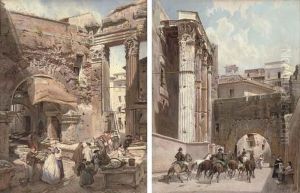Ludwig Pasini Paintings
Ludwig Johann Passini, often referred to as Ludwig Johann Pasini, was an Austrian narrative and genre painter born on July 9, 1832, in Vienna, Austria. His work often depicted scenes from everyday life, showcasing a blend of realism and romanticism. Although not as widely recognized as some of his contemporaries, Pasini's contribution to the art of the 19th century is notable for its delicate portrayal of social interactions and its meticulous attention to detail.
Pasini was born to a family of artists, which greatly influenced his early education and career path. His father, Johann Baptist von Pasini, was an engraver, and his mother, Carolina, née Pfeiffer, was also artistically inclined. Exposed to art from a young age, Pasini demonstrated a keen interest and talent for drawing and painting. He began his formal artistic training at the Academy of Fine Arts Vienna, where he studied under the guidance of Carl Gsellhofer, Leopold Kupelwieser, and Franz Eybl.
In his early career, Pasini focused on religious and historical subjects, but he soon developed a preference for genre painting, which became his main field of work. In 1850, he left Vienna for a study trip to Italy, which proved to be a crucial turning point in his artistic development. Influenced by the Italian lifestyle and the light of the south, his style evolved to incorporate brighter colors and a more relaxed, picturesque approach to his subjects.
Pasini achieved considerable success in his lifetime, and his works were exhibited in numerous art shows across Europe. He was particularly well-received in the Austro-Hungarian Empire, where his genre scenes of Italian life were especially popular. Pasini's paintings are characterized by their vivid detail, often capturing the subtleties of light and shadow, and the textures of fabrics and materials. His scenes often include people engaged in daily activities, imbued with a sense of narrative that invites the viewer to ponder the story behind the image.
Throughout his career, Pasini received several awards and honors, which solidified his reputation as a respected artist. He was a member of the Vienna Künstlerhaus and also associated with other artistic circles of his time. Despite the popularity of his work, Pasini did not establish a large school of followers, and his influence on subsequent generations was limited.
Ludwig Johann Passini died on November 6, 1903, in Venice, Italy. His works remain in several private collections and museums, mainly in Austria and Italy. He is remembered as a skilled genre painter who captured the charm and vibrancy of 19th-century European life with elegance and a keen eye for detail.
